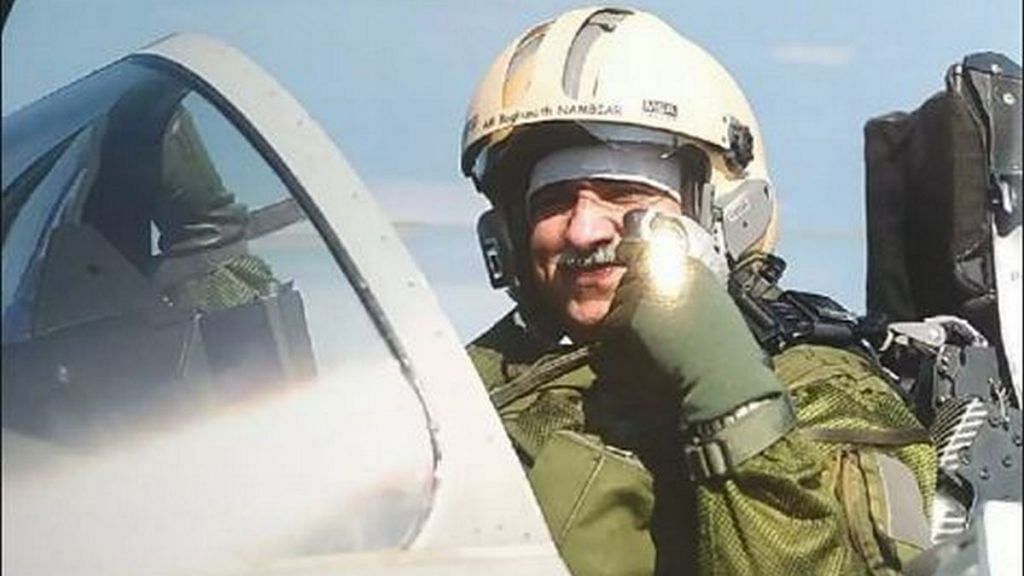When the Narendra Modi government announced Rakesh Bhadauria as the new chief of the Indian Air Force Thursday, it overlooked someone known for his heroics in the Kargil War: Air Marshal Raghunath Nambiar.
Currently the Air Officer Commanding-In-Chief of the Western Air Command, Raghunath Nambiar is widely credited with the first air strike using a laser guided bomb on Tiger Hill during the Kargil War. The repeatedly watched footage of Pakistani soldiers running before the missile strikes is also from Nambiar’s aircraft. All this is public knowledge, and doesn’t require repeating. What is less known is the jugaad that went into that strike, and the subsequent ones, during the impacting air campaign, Operation Safed Sagar, in Kargil.
India has a penchant for jugaad, seen as a national ability to overcome odds through native ingenuity, which cuts across regional, linguistic and technical boundaries. The early period of the Indian rocket programme too included some form of jugaad, those that are now the stuff of scientific legends. This proclivity kindles an across-the-board admiration, and stretches into combat as well – where Raghunath Nambiar’s critical role, that too in the heights of Kargil, can never be overstated.
Also read: RKS Bhadauria to take over as next Indian Air Force chief
Nambiar’s ingenuity
Within the Indian Air Force (IAF), Air Marshal Nambiar and another colleague of his are widely credited for coming up with a way that allowed French made Mirage 2000H to fire Israeli made laser guided bombs. It was, after all, a technology that France had denied India, and weeks into the air campaign in Kargil, this is what the IAF was sorely missing in its arsenal.
Various MiG-27 sorties, in their ground-attack role, had produced limited results. With targets dispersed at high altitudes, some ingenuity from the Indian side had become necessary. It was then that the Indian jugaad fooled the high-technology French circuitry into accepting Israeli Litening Pods as if they had always been germane to a Mirage 2000H aircraft. That cross technology marriage was the result of Indian brains coming up with ingenuity under extreme combat circumstances. In the Kargil War, Operation Safed Sagar proved to be the ultimate game-changer, backed by the heavy use of Mirage aircraft.
But Nambiar’s crucial role wasn’t limited to mixing technology and making Mirage more useful. His role in a previous operation had a far more critical impact for the soldiers on the ground, and could really be regarded as the turning point of India’s campaign to wrest the peaks back from Pakistani forces.
That operation is the outcome of some more jugaad, without which the enemy spots that needed to be targeted would not have been identified in the first place. This truly ended all hopes Pakistan had of holding on to the Kargil peaks.
Pakistan’s entire Kargil operation was dependent on an administrative and logistic camp set up at Muntho Dhalo, in the Batalik sector. Just as Tiger Hill was important for Pakistan, from which it directed devastating artillery fire, Muntho Dhalo was critical to maintaining the entire military campaign – from providing food, ammunition, and medical supplies to transiting soldiers. The location of the base had been speculated upon but never exactly identified. That is, until a Mirage 2000H duo, on an air defence sortie, picked up some footage through technological means that can also quite easily be classified as out-of-the-box thinking.
Going through the footage over and over again, the IAF figured out a camp of substantial size, but it was still difficult to identify it clearly as the snow cover helped conceal white tentage. Another sortie the following day gave a clearer picture of the scale and importance of Muntho Dhalo. On 17 June, multiple 1,000 lbs bombs fell on Muntho Dhalo, obliterating it completely, and with that Pakistan’s lifeline to the peaks.
Also read: Kargil hero R Nambiar takes over as chief of Western Air Command along Pakistan border
Overlooking something crucial
It is hardly surprising that Air Marshal Nambiar was awarded a Vayu Sena Medal for gallantry.
But years later, when the time came to suitably reward him and put his ability to greater use, the Indian government overlooked him for the top job of IAF chief. The commander-in-chief was in the running for the post, along with three others, and his (un)conventional combat experience that helped India overwhelmingly during the Kargil War, should have tipped the balance in his favour.
Of course, it is the government’s prerogative to pick whomsoever it wants to, but combat experience, and not seniority, has been used to elevate someone to the top job on earlier occasions (for instance, in the case of Army Chief General Bipin Rawat). That the government doesn’t value jugaad in combat is more saddening, but obviously the 21st century is very different from the 20th century.
The Air Force announced the Pakistani casualty figures for Muntho Dhalo six months after the ceasefire in 1999, after it had verified the numbers. In 2019, hours after the Balakot air strike on 26 February, media reports based on ‘official sources’ claimed hundreds killed, including a brother-in-law of JeM chief Masood Azhar. The government had later said there were no Pakistani soliders or civilians killed in the air strike.
The author is a Congress leader and Editor-in-Chief of Defence & Security Alert. Views are personal.
